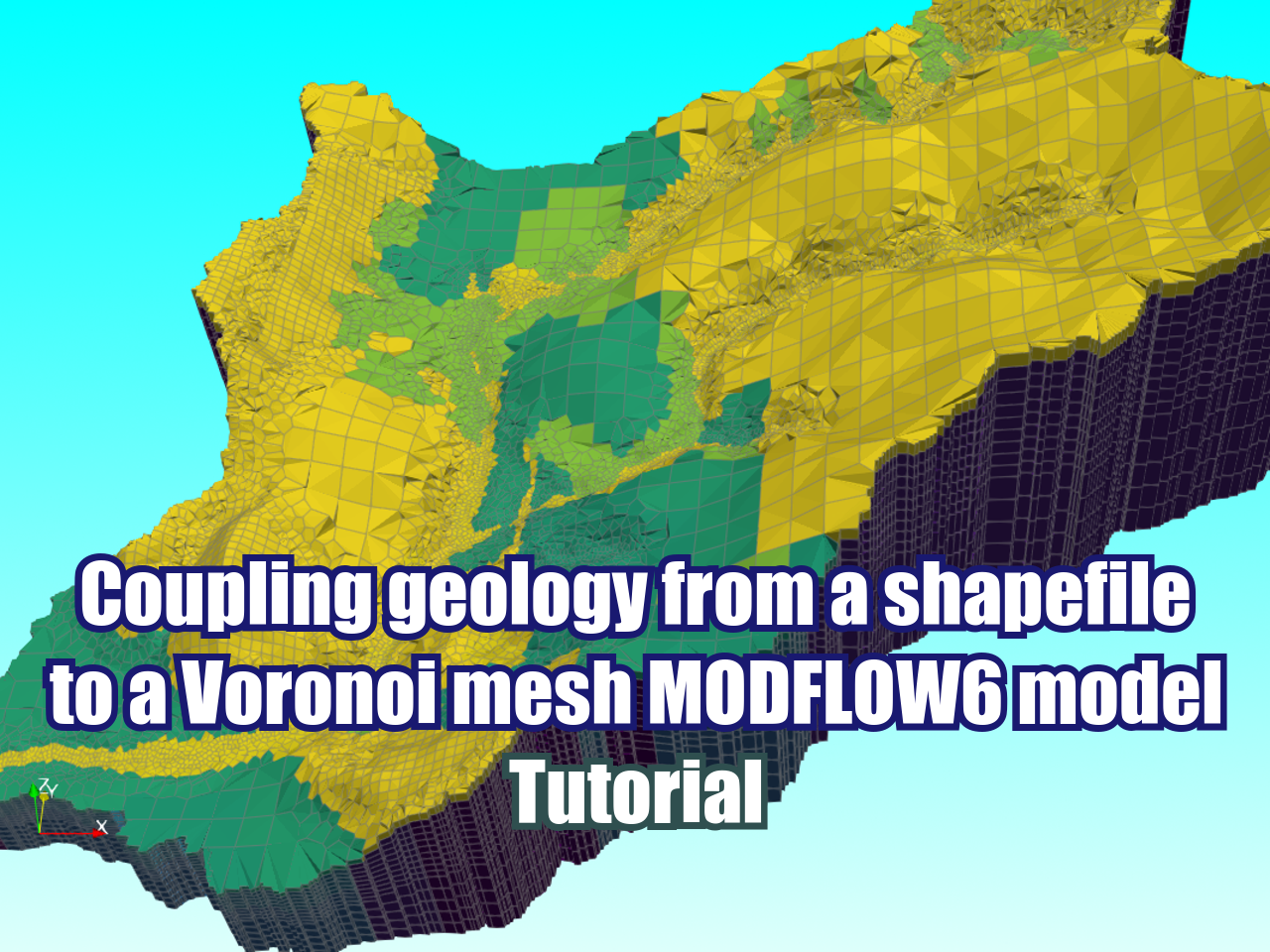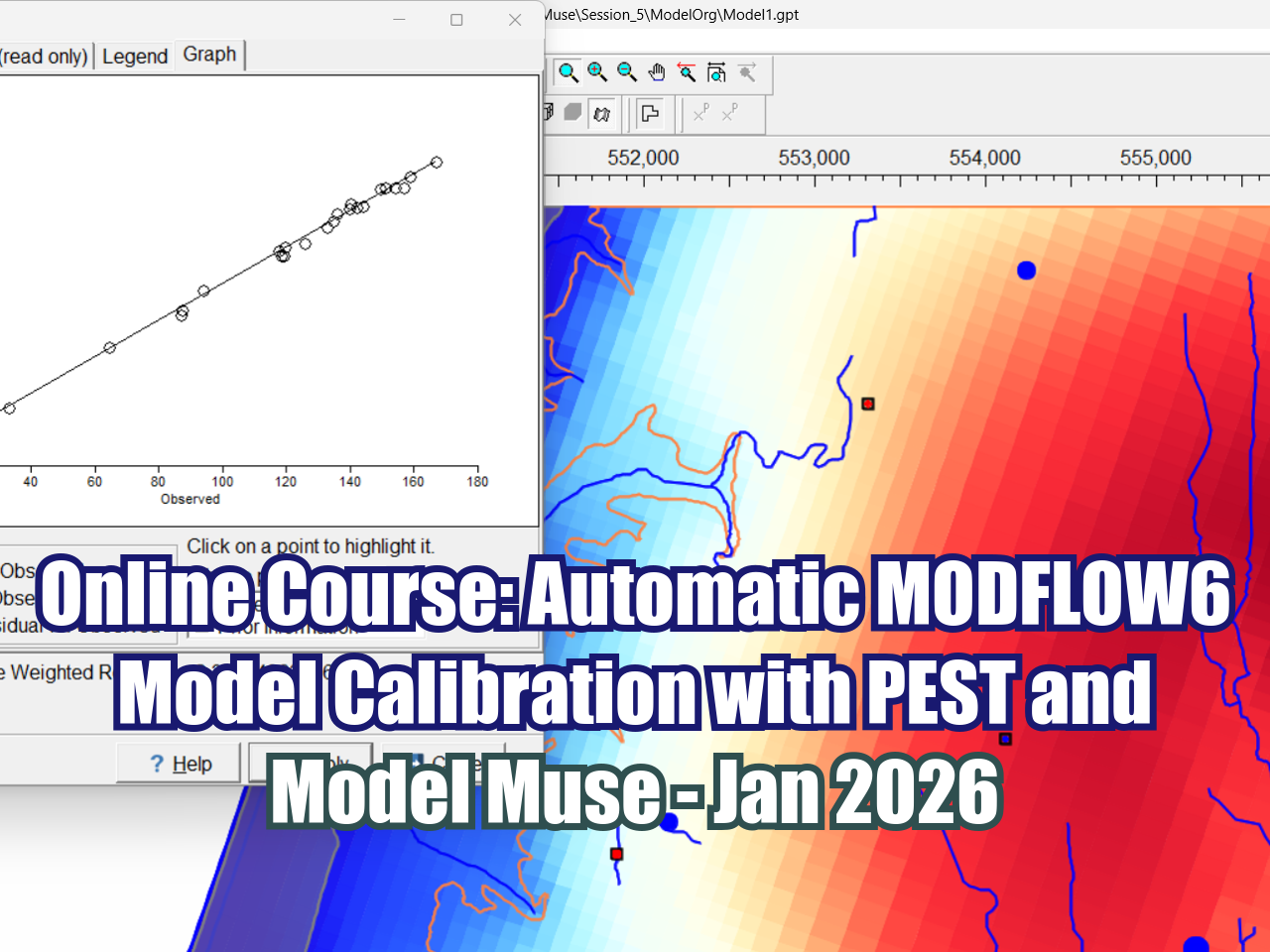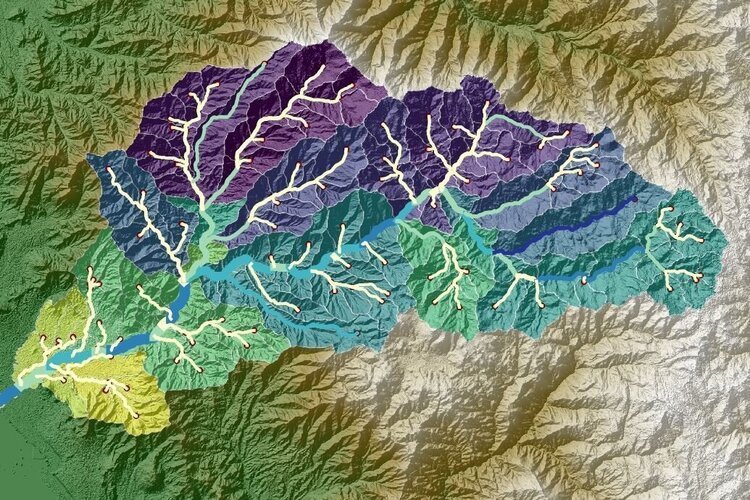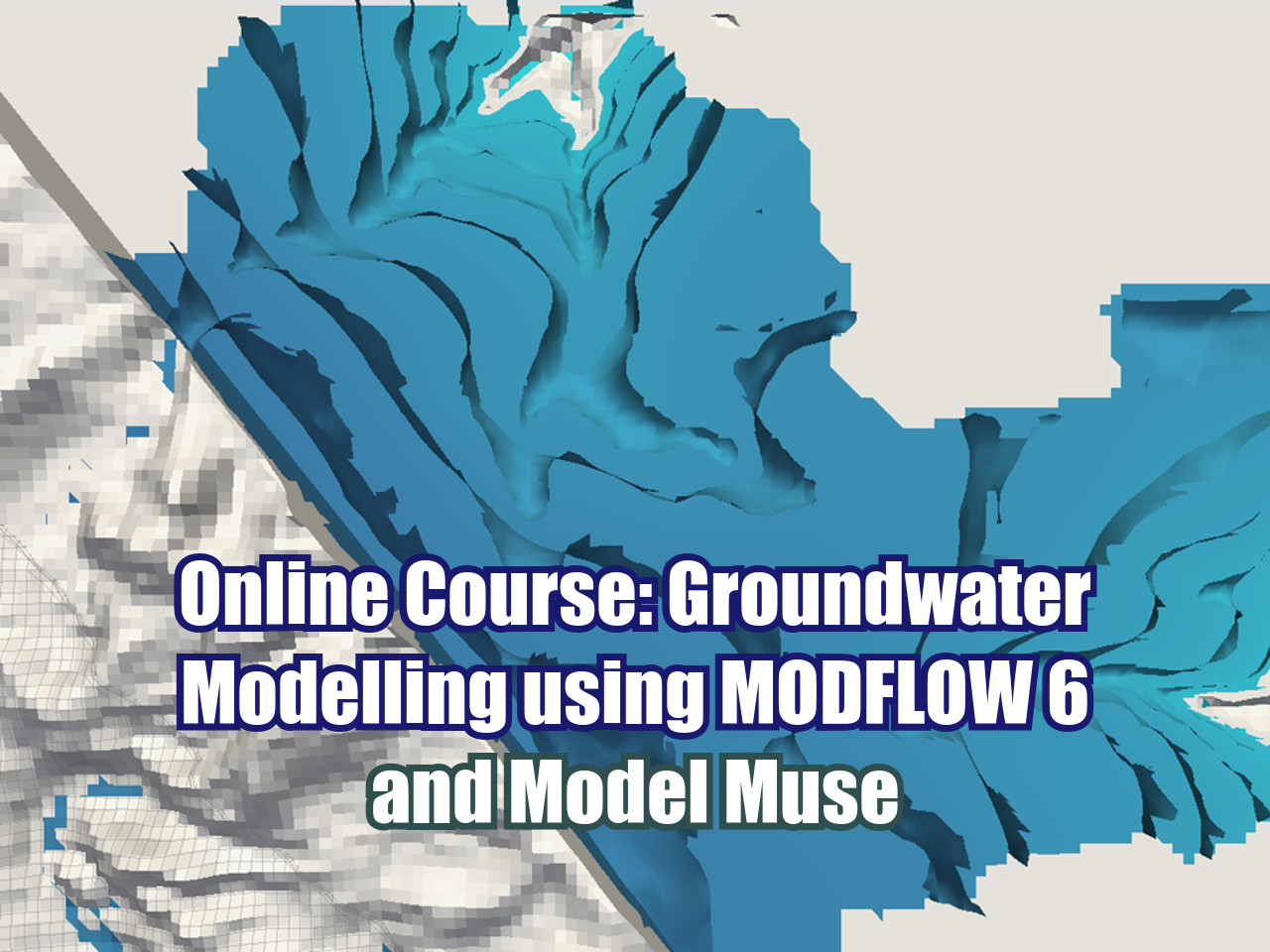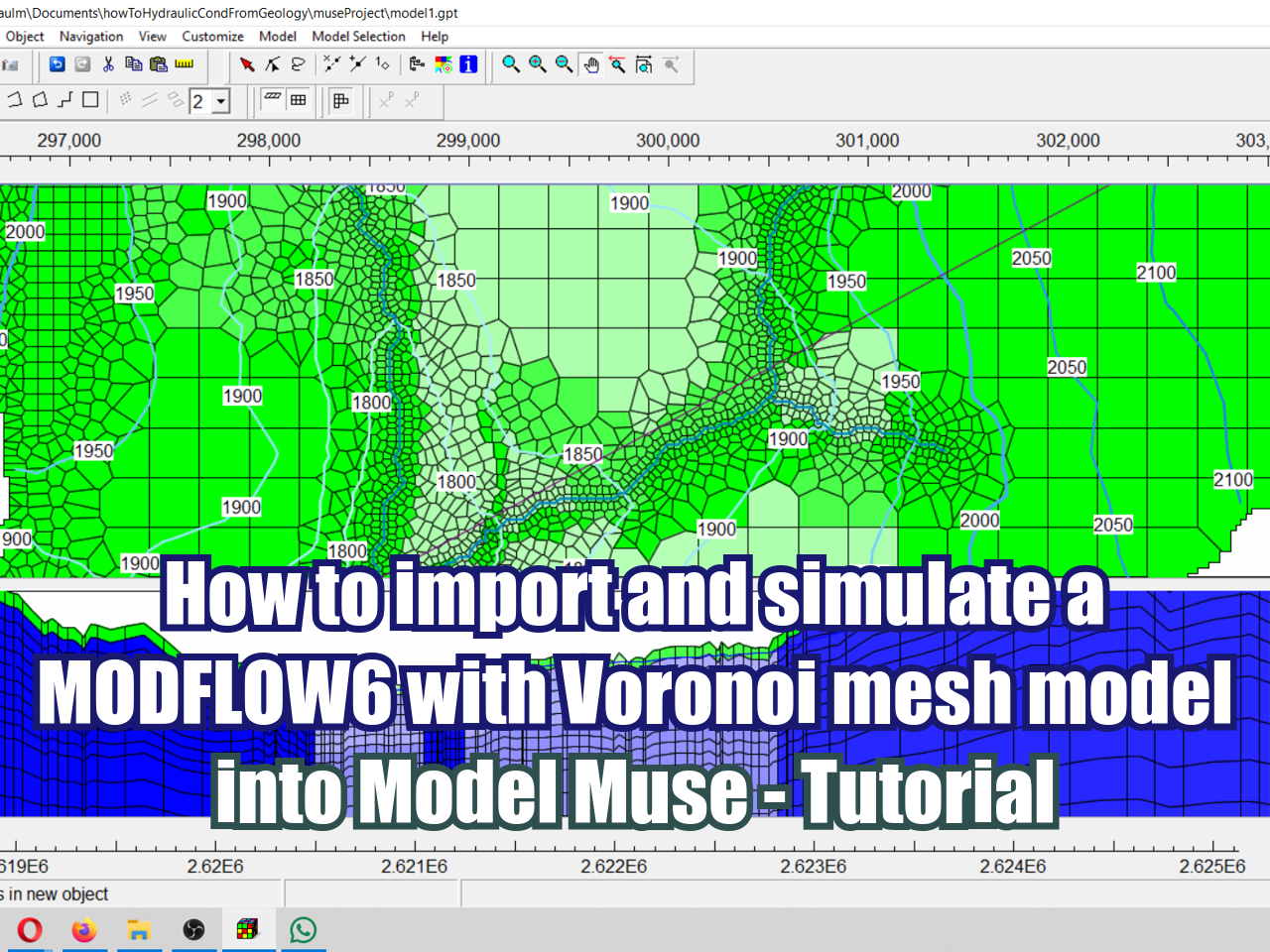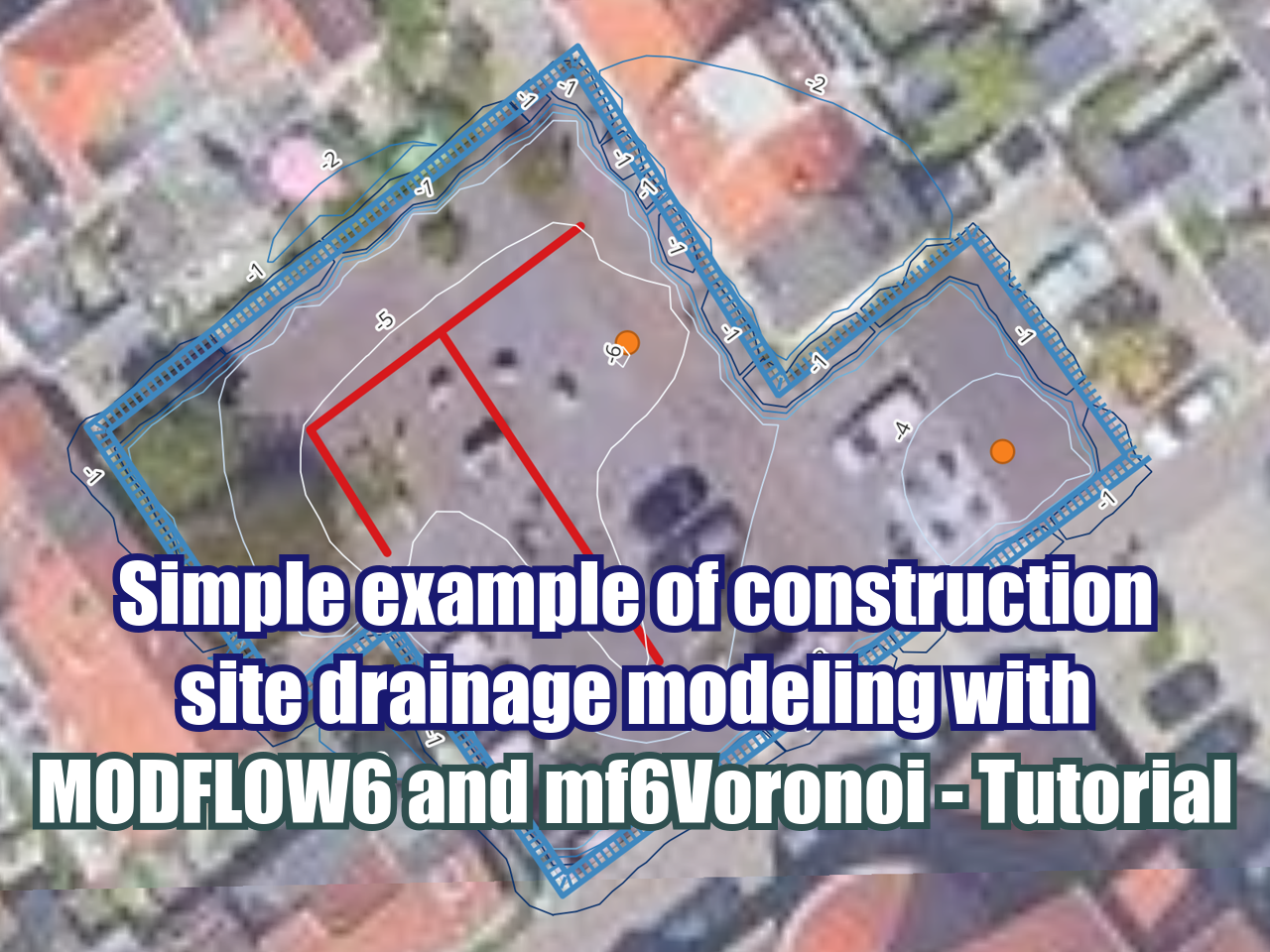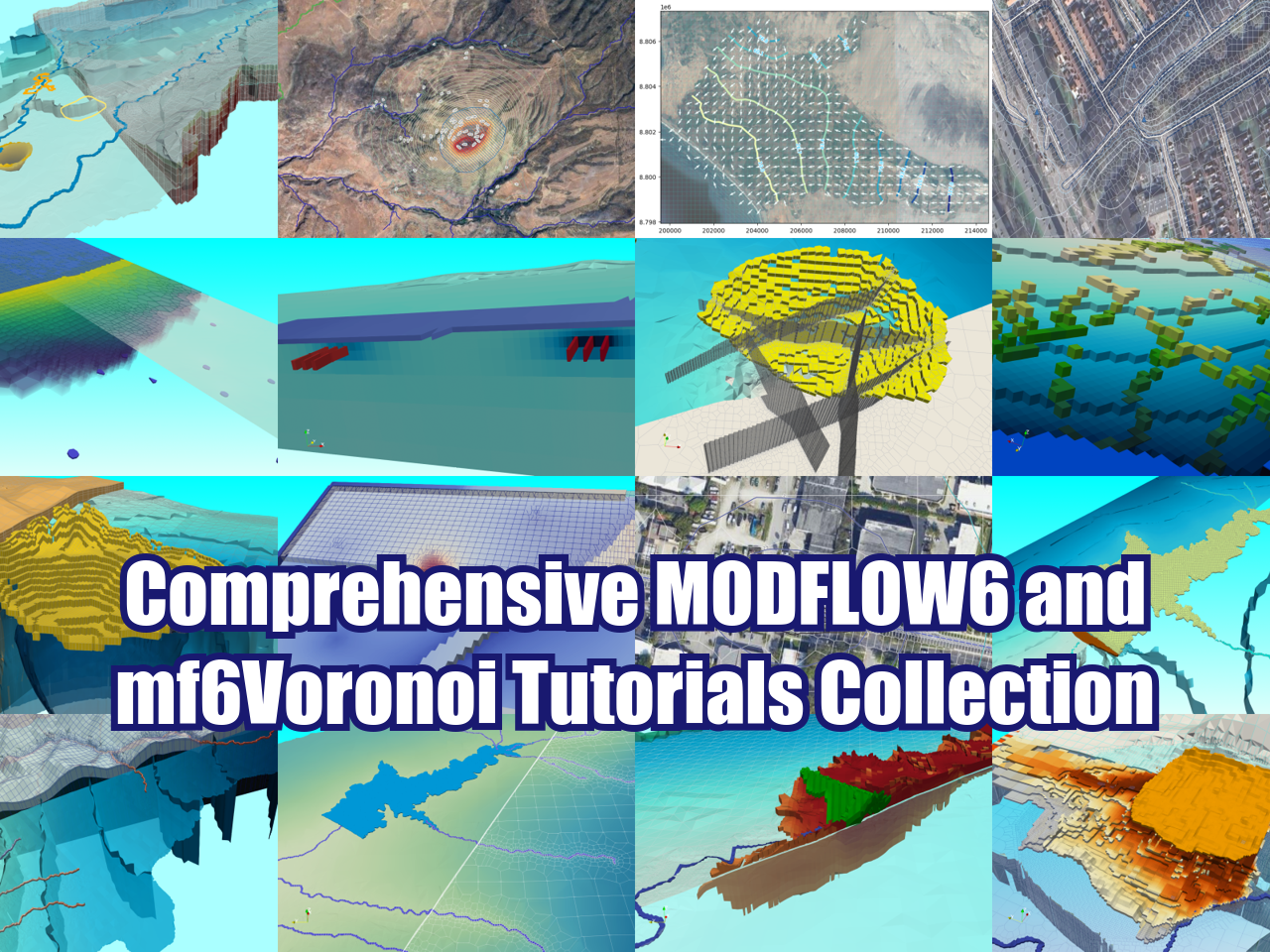Coupling geology from a shapefile to a Voronoi mesh MODFLOW6 model - Tutorial
/A practical approach to set up hydraulic conductivity to a MODFLOW 6 model based on geological polygons. The tutorial show all steps from mesh and model creation, the setup of hydraulic parameters and the 3d representation of the final distribution in Paraview.
Tutorial
Código
from mf6Voronoi.utils import initiateOutputFolder
import flopy
from mf6Voronoi.utils import listTemplates, copyTemplate#get the latest modflow binary
binDir = '../bin'
initiateOutputFolder(binDir)The output folder ../bin exists and has been clearedflopy.utils.get_modflow(binDir, subset=['mf6'])fetched release '23.0' info from MODFLOW-ORG/executables
using previous download 'C:\Users\saulm\Downloads\modflow_executables-23.0-win64.zip' (use 'force=True' to re-download)
extracting 1 file to 'C:\Users\saulm\Documents\howToHydraulicCondFromGeology\bin'
mf6.exe (6.6.3)
updated flopy metadata file: 'C:\Users\saulm\AppData\Local\flopy\get_modflow.json'#listTemplates()copyTemplate('generateVoronoi','geo')copyTemplate('modelCreation','geo')copyTemplate('vtkGeneration','geo')Mesh generation
Part 1 : Voronoi mesh generation
import warnings ## Org
warnings.filterwarnings('ignore') ## Org
import os, sys ## Org
import geopandas as gpd ## Org
from mf6Voronoi.geoVoronoi import createVoronoi ## Org
from mf6Voronoi.meshProperties import meshShape ## Org
from mf6Voronoi.utils import initiateOutputFolder, getVoronoiAsShp ## Org#Create mesh object specifying the coarse mesh and the multiplier
vorMesh = createVoronoi(meshName='coupleGeology',maxRef = 250, multiplier=1, overlapping=False) ## Org
#Open limit layers and refinement definition layers
vorMesh.addLimit('basin','../shp/hatariUtils/catchment.shp') ## Org
vorMesh.addLayer('river','../shp/hatariUtils/river_basin.shp',40) ## Org
vorMesh.addLayer('gunsight','../shp/gunsightFormation.shp',80) ## Org#Generate point pair array
vorMesh.generateOrgDistVertices() ## Org
#Generate the point cloud and voronoi
vorMesh.createPointCloud() ## Org
vorMesh.generateVoronoi() ## OrgFollow us: |
|
|
|
|
|
|
/--------Layer river discretization-------/
Progressive cell size list: [40, 80, 120, 160, 200, 240] m.
/--------Layer gunsight discretization-------/
Progressive cell size list: [80, 160, 240] m.
/----Sumary of points for voronoi meshing----/
Distributed points from layers: 2
Points from layer buffers: 5478
Points from max refinement areas: 551
Points from min refinement areas: 1242
Total points inside the limit: 8355
/--------------------------------------------/
Time required for point generation: 1.97 seconds
/----Generation of the voronoi mesh----/
Time required for voronoi generation: 1.44 seconds#Uncomment the next two cells if you have strong differences on discretization or you have encounter an FORTRAN error while running MODFLOW6vorMesh.checkVoronoiQuality(threshold=0.005)/----Performing quality verification of voronoi mesh----/
Short side on polygon: 8358 with length = 0.00036
Short side on polygon: 8358 with length = 0.00036
Short side on polygon: 8358 with length = 0.00029
Short side on polygon: 8358 with length = 0.00029
Short side on polygon: 8358 with length = 0.00194
Short side on polygon: 8358 with length = 0.00194
Short side on polygon: 8358 with length = 0.00395
Short side on polygon: 8358 with length = 0.00395vorMesh.fixVoronoiShortSides()
vorMesh.generateVoronoi()
vorMesh.checkVoronoiQuality(threshold=0.005)/----Generation of the voronoi mesh----/
Time required for voronoi generation: 1.59 seconds
/----Performing quality verification of voronoi mesh----/
Your mesh has no edges shorter than your threshold#Export generated voronoi mesh
initiateOutputFolder('../output') ## Org
getVoronoiAsShp(vorMesh.modelDis, shapePath='../output/'+vorMesh.modelDis['meshName']+'.shp') ## OrgThe output folder ../output has been generated.
/----Generation of the voronoi shapefile----/
Time required for voronoi shapefile: 1.94 seconds# Show the resulting voronoi mesh
#open the mesh file
mesh=gpd.read_file('../output/'+vorMesh.modelDis['meshName']+'.shp') ## Org
#plot the mesh
mesh.plot(figsize=(35,25), fc='crimson', alpha=0.3, ec='teal') ## OrgPart 2 generate disv properties
# open the mesh file
mesh=meshShape('../output/'+vorMesh.modelDis['meshName']+'.shp') ## Org# get the list of vertices and cell2d data
gridprops=mesh.get_gridprops_disv() ## OrgCreating a unique list of vertices [[x1,y1],[x2,y2],...]
100%|███████████████████████████████████████████████████████████████████████████| 8363/8363 [00:00<00:00, 18441.82it/s]
Extracting cell2d data and grid index
100%|████████████████████████████████████████████████████████████████████████████| 8363/8363 [00:03<00:00, 2451.03it/s]#create folder
initiateOutputFolder('../json') ## Org
#export disv
mesh.save_properties('../json/disvDict.json') ## OrgThe output folder ../json has been generated.Model creation on steady state
Part 2a: generate disv properties
import sys, json, os ## Org
import rasterio, flopy ## Org
import numpy as np ## Org
import matplotlib.pyplot as plt ## Org
import geopandas as gpd ## Org
from mf6Voronoi.meshProperties import meshShape ## Org
from shapely.geometry import MultiLineString ## Org# open the json file
with open('../json/disvDict.json') as file: ## Org
gridProps = json.load(file) ## Orgcell2d = gridProps['cell2d'] #cellid, cell centroid xy, vertex number and vertex id list
vertices = gridProps['vertices'] #vertex id and xy coordinates
ncpl = gridProps['ncpl'] #number of cells per layer
nvert = gridProps['nvert'] #number of verts
centroids=gridProps['centroids'] #cell centroids xyPart 2b: Model construction and simulation
#Extract dem values for each centroid of the voronois
src = rasterio.open('../rst/modelDem.tif') ## Org
elevation=[x for x in src.sample(centroids)] ## Orgnlay = 15 ## Org
mtop=np.array([elev[0] for i,elev in enumerate(elevation)]) ## Org
zbot=np.zeros((nlay,ncpl)) ## Org
AcuifInf_Bottom = 1300 ## Org
zbot[0,] = AcuifInf_Bottom + (0.95 * (mtop - AcuifInf_Bottom)) ## Org
zbot[1,] = AcuifInf_Bottom + (0.9 * (mtop - AcuifInf_Bottom)) ## Org
zbot[2,] = AcuifInf_Bottom + (0.85 * (mtop - AcuifInf_Bottom)) ## Org
zbot[3,] = AcuifInf_Bottom + (0.8 * (mtop - AcuifInf_Bottom)) ## Org
zbot[4,] = AcuifInf_Bottom + (0.75 * (mtop - AcuifInf_Bottom)) ## Org
zbot[5,] = AcuifInf_Bottom + (0.7 * (mtop - AcuifInf_Bottom)) ## Org
zbot[6,] = AcuifInf_Bottom + (0.65 * (mtop - AcuifInf_Bottom)) ## Org
zbot[7,] = AcuifInf_Bottom + (0.6 * (mtop - AcuifInf_Bottom)) ## Org
zbot[8,] = AcuifInf_Bottom + (0.55 * (mtop - AcuifInf_Bottom)) ## Org
zbot[9,] = AcuifInf_Bottom + (0.5 * (mtop - AcuifInf_Bottom)) ## Org
zbot[10,] = AcuifInf_Bottom + (0.4 * (mtop - AcuifInf_Bottom)) ## Org
zbot[11,] = AcuifInf_Bottom + (0.3 * (mtop - AcuifInf_Bottom)) ## Org
zbot[12,] = AcuifInf_Bottom + (0.2 * (mtop - AcuifInf_Bottom)) ## Org
zbot[13,] = AcuifInf_Bottom + (0.1 * (mtop - AcuifInf_Bottom)) ## Org
zbot[14,] = AcuifInf_BottomCreate simulation and model
# create simulation
simName = 'mf6Sim' ## Org
modelName = 'mf6Model' ## Org
modelWs = '../modelFiles' ## Org
sim = flopy.mf6.MFSimulation(sim_name=modelName, version='mf6', ## Org
exe_name='../bin/mf6.exe', ## Org
sim_ws=modelWs) ## Org# create tdis package
tdis_rc = [(1000.0, 1, 1.0)] ## Org
tdis = flopy.mf6.ModflowTdis(sim, pname='tdis', time_units='SECONDS', ## Org
perioddata=tdis_rc) ## Org# create gwf model
gwf = flopy.mf6.ModflowGwf(sim, ## Org
modelname=modelName, ## Org
save_flows=True, ## Org
newtonoptions="NEWTON UNDER_RELAXATION") ## Org# create iterative model solution and register the gwf model with it
ims = flopy.mf6.ModflowIms(sim, ## Org
complexity='COMPLEX', ## Org
outer_maximum=50, ## Org
inner_maximum=30, ## Org
linear_acceleration='BICGSTAB') ## Org
sim.register_ims_package(ims,[modelName]) ## Org# disv
disv = flopy.mf6.ModflowGwfdisv(gwf, nlay=nlay, ncpl=ncpl, ## Org
top=mtop, botm=zbot, ## Org
nvert=nvert, vertices=vertices, ## Org
cell2d=cell2d) ## Org# initial conditions
ic = flopy.mf6.ModflowGwfic(gwf, strt=np.stack([mtop for i in range(nlay)])) ## OrgKxArray = np.ones((nlay, ncpl)) * 4e-4
KxArray[1:6] = 5e-6
KxArray[6:15] = 3e-6
KxArray[15:] = 7e-7
icelltype = [1 for x in range(7)] + [0 for x in range(nlay - 7)]
interIx = flopy.utils.gridintersect.GridIntersect(gwf.modelgrid) ## Org
geoDf = gpd.read_file('../shp/geology.shp')
#looping over the geology polygons
for index, row in geoDf.iterrows():
geoCells=interIx.intersect(row.geometry).cellids
# for aluvial layers, that has 'alluvium' or 'deposit' on the notes
if 'alluvium' in row.Notes or 'deposits' in row.Notes:
for cell in geoCells:
KxArray[0,cell] = row.Cond #only apply to the first layer
#for the rest of layers
else:
for cell in geoCells:
KxArray[1:,cell] = row.Cond #apply to the remaining layers below layer 1
# node property flow
npf = flopy.mf6.ModflowGwfnpf(gwf, ## Org
save_specific_discharge=True, ## Org
icelltype=icelltype, ## Org
k=KxArray,
k33=KxArray/10) ## Org#cross section over the main river
crossSection = gpd.read_file('../shp/crossSection.shp') ## Org
sectionLine =list(crossSection.iloc[0].geometry.coords) ## Org
fig, ax = plt.subplots(figsize=(12,8)) ## Org
modelxsect = flopy.plot.PlotCrossSection(model=gwf, line={'Line': sectionLine}) ## Org
linecollection = modelxsect.plot_grid(lw=0.5) ## Org
modelxsect.plot_array(np.log(npf.k.array), cmap='viridis', alpha=0.5)
ax.grid() ## Orgsim.write_simulation()writing simulation...
writing simulation name file...
writing simulation tdis package...
writing solution package ims_-1...
writing model mf6Model...
writing model name file...
writing package disv...
writing package ic...
writing package npf...3d geometry generation on Vtk format
#Vtk generation
import flopy ## Org
from mf6Voronoi.tools.vtkGen import Mf6VtkGenerator ## Org
from mf6Voronoi.utils import initiateOutputFolder ## Org# load simulation
simName = 'mf6Sim' ## Org
modelName = 'mf6Model' ## Org
modelWs = '../modelFiles' ## Org
sim = flopy.mf6.MFSimulation.load(sim_name=modelName, version='mf6', ## Org
exe_name='bin/mf6.exe', ## Org
sim_ws=modelWs) ## Orgloading simulation...
loading simulation name file...
loading tdis package...
loading model gwf6...
loading package disv...
loading package ic...
loading package npf...
loading solution package mf6model...vtkDir = '../vtk' ## Org
initiateOutputFolder(vtkDir) ## Org
mf6Vtk = Mf6VtkGenerator(sim, vtkDir) ## OrgThe output folder ../vtk has been generated.Follow us: |
|
|
|
|
|
|
/---------------------------------------/
The Vtk generator engine has been started
/---------------------------------------/#list models on the simulation
mf6Vtk.listModels() ## OrgModels in simulation: ['mf6model']mf6Vtk.loadModel(modelName) ## OrgPackage list: ['DISV', 'IC', 'NPF']#generate model geometry as vtk and parameter array
mf6Vtk.generateGeometryArrays() ## Org#generate parameter vtk
mf6Vtk.generateParamVtk() ## OrgParameter Vtk Generated

